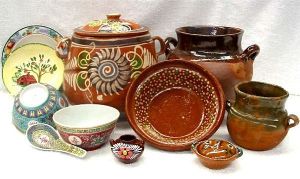We've known for nearly 100 years that Mexican pottery is often finished with lead glaze, which poses a threat to those who produce the pots as well as those who eat from them.
But it was only in 1991, when the daughter of the US ambassador to Mexico was found to have high lead in her blood, that the outcry began to grow in both the United States and Mexico to end the use of lead glaze on pottery.
It is already illegal to import into the United States pottery that is not certified as lead free by an inscription on the pot saying sin plomo, or "without lead." But in Mexico, with its 120 million people - millions of them children whose growing nervous systems are the prime victims of lead - the threat of neurological damage remains high.
Don González, for example, (not his real name) was a pottery artisan who suffered from headaches and felt tired most of the time. Several doctors could not give him a good diagnosis, but a young doctor, following his symptoms by the book, felt he might be poisoned by lead. She was the first doctor to ask for his profession. Unfortunately the doctor did not ask Don González to stop using lead glaze, but just gave him medicine to reduce the lead in his body. He is still exposed to lead.
US medical authorities recently lowered the acceptable level of lead in American children to 5 micrograms per deciliter of lead in their blood. But Mexico's children frequently are found to have 10 to 20 times as much lead in their blood.
The colorful earthenware pots are in part responsible. Mexican cooking and storage of highly acidic foods such as salsa help lift the lead out of the glaze - straight into the food and into the children who eat that food.
As a result, according to a recent scientific paper, children with high lead lose an average of 5 points on their IQ.
 |
And they have many problems with emotional outbursts in school. A second paper went so far as to link high lead in children's blood with their later engagement in violence.
As with many diseases and toxic waste threats, when it happens far away in a nation lacking extensive scientific, financial, and organizational assets, it's largely swept under the rug.
Back in the 1980s, when I told friends from Morocco and Algiers that America had learned that chemicals to fireproof baby clothing caused cancer, and these were now being dumped in Third World countries lacking capacity to identify the dangerous clothing, I got laughed at.
"We fear our children will die of the cold, not from some trace chemicals in the clothing," said one man.
Now, 20 years after Ambassador John Negroponte felt the fear of discovering toxic lead in his child, the Blacksmith Institute, a non-governmental organization, or NGO, based in New York, is working with the Mexican government to end the use of lead in pottery.
This is an effort fraught with sensitive issues, the most important being that outsiders - no matter how well-meaning - risk creating a nationalistic backlash if foreigners are leading the push for action.
Blacksmith, like aid groups in many countries, walks a fine line. It must show respect and deference to the local authorities, and push gently to educate, inspire, support, and engage these local authorities from the ministries of health, science, trade, security, justice, and education. Only when Mexican authorities, potters, and consumers learn the risks involved and learn how to shift to lead-free pottery, will Mexico's children be safe.
So Blacksmith is working with local NGO staff in Tlayacapan and other small communities to raise awareness. The campaign will be based mainly on posters and, if possible, enforced with the help of public and religious authorities.
The Blacksmith team is also launching a state campaign that will use any media that is willing to give them free space: radio, newspapers, TV, etc. The turn to media comes after some difficulties in straightforward enactment of laws and enforcement.
At first, anti-lead activists proposed destroying tens of thousands of artisanal local pottery kilns and replacing them with high temperature gas kilns than could fix the lead in the pottery so it would not get into food and then into people.
That costly proposal went nowhere.
 |
At the same time, since 1991, a public agency supporting artisans, FONART, backed research, policies and enforcement to end lead in pottery.
Blacksmith and FONART supported scientists at Mexican universities who invented a lead-free glaze that could be applied at moderate temperatures of the traditional kilns and looked as glossy as lead glaze. But people resist change; and the potters are no different. They fear that the new glaze won't be as beautiful, as durable, and as popular as the traditional leaded glazes.
Now the advocates of ending lead in pottery - and in the blood of Mexico's people - are working on their pilot project in Morelos State near Mexico City, to see if laws already on the books can be used to prod the potters into replacing lead with non-lead glazes.
Today, there are about 100 workshops that produce lead free pottery for export or for health reasons. But few Mexicans know about lead dangers in pottery.
There are many reasons that lead persists in Mexico's pottery:
• The government says there are 10,000 artisanal potters but some estimates say 50,000 is the real number. They are widespread and often live in rural areas with limited access to health workers, and they sell in unregulated, informal markets.
• Anti-lead laws are federal. States are expected to enforce them - dividing responsibility.
• Potters are a social subculture and government officials fear to disturb them.
• Lead is cheap and available while detection equipment is scarce and costly.
• Lead free certification requires an official brand on pottery - but the brands can be counterfeited easily.
Getting rid of lead in pottery will require a major media campaign, according to Blacksmith, which specializes in cleaning up toxic sites in developing countries polluted with lead, mercury, chromium, pesticides, and other substances.
But a media campaign - most Mexicans have access to radio and tv - risks creating terrible hardship to the potter community which may number in the millions. That's because many Mexicans have reacted in the past to the threat of lead by stopping the use of pottery.
"Lead in pottery is a 500 years old problem that is not and will not be a priority on the current administration," said one Blacksmith expert.
Original Story


